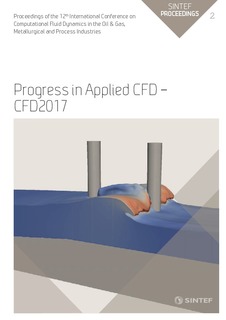| dc.contributor.author | Kamath, Arun | |
| dc.contributor.author | Alagan Chella, Mayilvahanan | |
| dc.contributor.author | Bihs, Hans | |
| dc.contributor.author | Arntsen, Øivind A. | |
| dc.date.accessioned | 2018-01-29T06:50:49Z | |
| dc.date.available | 2018-01-29T06:50:49Z | |
| dc.date.issued | 2017 | |
| dc.identifier.isbn | 978-82-536-1544-8 | |
| dc.identifier.issn | 2387-4295 | |
| dc.identifier.uri | http://hdl.handle.net/11250/2480096 | |
| dc.description.abstract | The interaction of breaking waves with marine structures involves complex free surface deformation and instantaneous loading on the structural members. A typical offshore platform or a coastal structure consists of several vertical and horizontal members exposed to breaking wave action. The breaking wave hydrodynamics and the effect of neighbouring cylinders on multiple cylinders placed in near vicinity is important due to force amplification or reduction resulting from interaction between the cylinders. The kinematics of breaking waves and the hydrodynamics of breaking wave interaction with a single vertical cylinder have been studied in detail in current literature. Studies have established that the location of a cylinder with respect to the wave breaking point has a major influence on the breaking wave forces on the cylinder. These studies have to be extended to investigate the hydrodynamics of cylinders placed close to each other to understand the modifications in the force regime due to the presence of neighbouring cylinders under a breaking wave regime. In this paper, the open-source Computational Fluid Dynamics (CFD) model REEF3D is used to simulate breaking wave interaction with a pair of tandem cylinders. The focus of the study is on the location of the wave breaking point with respect to the upstream cylinder and the consequences for the downstream cylinder. The free surface features associated with the incident breaking wave and the evolution of the free surface after interaction with the upstream cylinder are investigated. The overturning wave crest and the associated free surface deformation have a major influence on the wave that is then incident on the downstream cylinder. The development of a downstream jet behind the upstream cylinder leads to the negation of the shadowing effect on the downstream cylinder. This can lead to an unexpected higher force on the downstream cylinder. The evolution of this downstream jet and the extent of this phenomenon changes the character of the otherwise shadow region behind the upstream cylinder. A detailed understanding of this phenomenon can provide new insights into the wave hydrodynamics related to multiple cylinders placed in close vicinity under a breaking wave regime. The knowledge regarding force amplification or reduction on downstream cylinders will aid in designing a safer and reliable substructure for marine installations. | |
| dc.language.iso | eng | |
| dc.publisher | SINTEF Academic Press | |
| dc.relation.ispartof | Progress in Applied CFD – CFD2017 Selected papers from 12th International Conference on Computational Fluid Dynamics in the Oil & Gas, Metallurgical and Process Industries | |
| dc.relation.ispartof | Proceedings of the 12th International Conference on Computational Fluid Dynamics in the Oil & Gas, Metallurgical and Process Industries | |
| dc.relation.ispartofseries | SINTEF Proceedings;2 | |
| dc.subject | CFD | |
| dc.subject | Hydrodynamics | |
| dc.subject | Breaking wave | |
| dc.subject | Wave force | |
| dc.subject | Tandem cylinders | |
| dc.title | Influence of the upstream cylinder and wave breaking point on the breaking wave forces on the downstream cylinder | |
| dc.type | Chapter | |
| dc.type | Conference object | |
| dc.type | Peer reviewed | |
| dc.description.version | publishedVersion | |
| dc.subject.nsi | VDP::Technology: 500 | |
